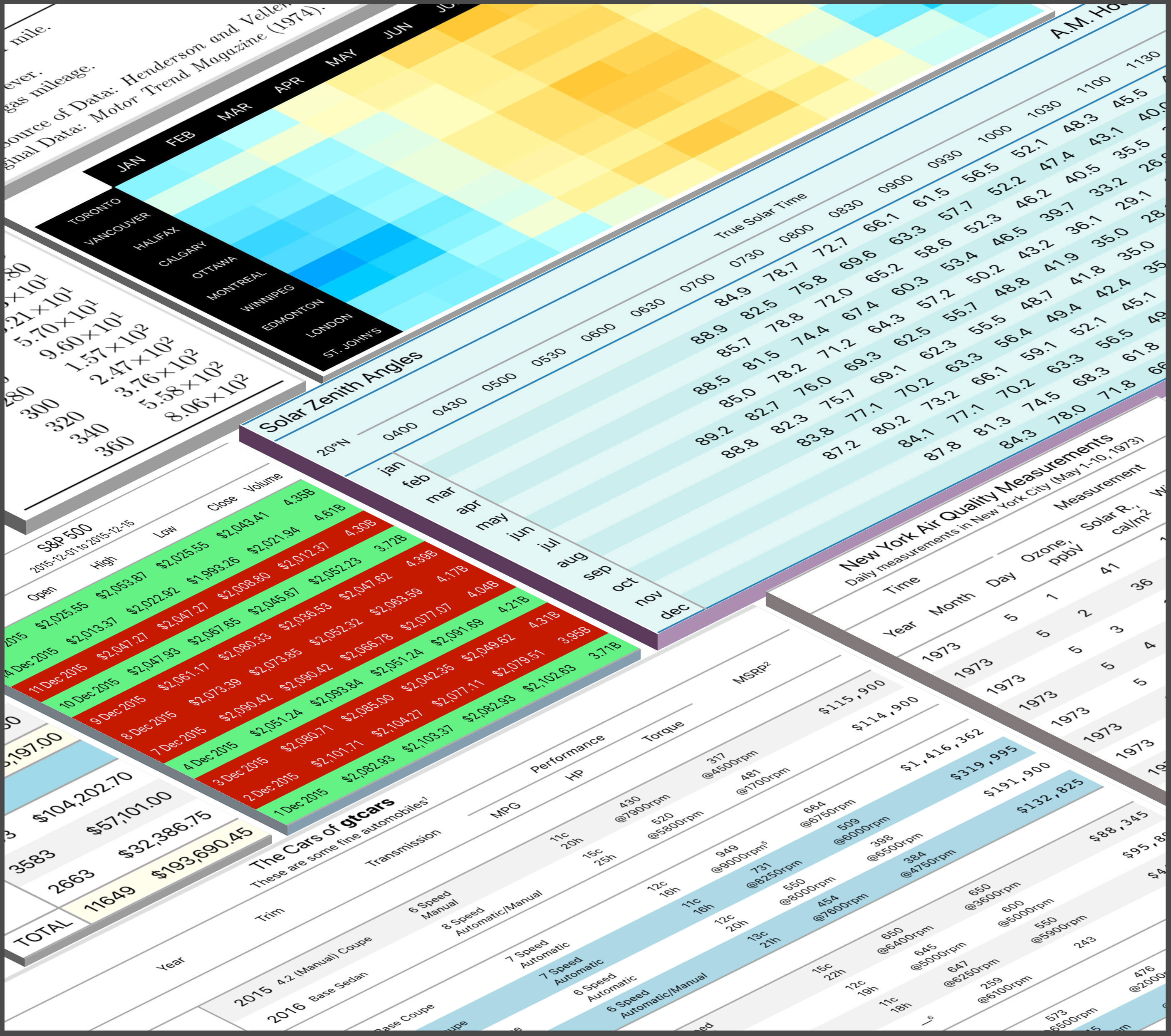With the gt package, anyone can make wonderful-looking tables using the R programming language. The gt philosophy: we can construct a wide variety of useful tables with a cohesive set of table parts. These include the table header, the stub, the column labels and spanner column labels, the table body, and the table footer.
It all begins with table data (be it a tibble or a data frame). You
then decide how to compose your gt table with the elements and
formatting you need for the task at hand. Finally, the table is rendered
by printing it at the console, including it in an R Markdown document,
or exporting to a file using gtsave(). Currently, gt supports the
HTML, LaTeX, and RTF output formats.
The gt package is designed to be both straightforward yet powerful.
The emphasis is on simple functions for the everyday display table
needs. Here is a brief example of how to use gt to create a table
from the included sp500 dataset:
library(gt)
library(tidyverse)
library(glue)
# Define the start and end dates for the data range
start_date <- "2010-06-07"
end_date <- "2010-06-14"
# Create a gt table based on preprocessed
# `sp500` table data
sp500 %>%
filter(date >= start_date & date <= end_date) %>%
select(-adj_close) %>%
gt() %>%
tab_header(
title = "S&P 500",
subtitle = glue("{start_date} to {end_date}")
) %>%
fmt_date(
columns = date,
date_style = 3
) %>%
fmt_currency(
columns = c(open, high, low, close),
currency = "USD"
) %>%
fmt_number(
columns = volume,
suffixing = TRUE
)There are six datasets included in gt: countrypops, sza,
gtcars, sp500, pizzaplace, and exibble. All of them are useful
for experimenting with gt’s functions.
Beyond this simple example, there are many functions available in gt for creating super-customized tables.
Want to try this out? Then, take the gt Test Drive on RStudio Cloud. It’s full of ready-to-run examples.
The gt package can be installed from CRAN with:
install.packages("gt")You can also choose to install the development version of gt from GitHub:
devtools::install_github("rstudio/gt")If you encounter a bug, have usage questions, or want to share ideas to make this package better, please feel free to file an issue.
The gt package joins a burgeoning collection of packages for display table generation. Why another? We feel that there is enough room in this space to innovate further. Here are some of the ways that gt contributes to this ecosystem:
- the interface is high-level and declarative (general instructions versus very specific)
- the formatting options are ‘batteries included’ (scientific notation, uncertainty, ranges, percentages, suffixes, localized currency, dates/times + much more)
- there is excellent, pain-free support for footnotes
- the output is ‘camera-ready’
- multiple output formats are supported with the same declarative interface
- the API closely follows tidyverse conventions by adhering to the tidyverse style guide
- there’s a focus on making the package documentation and examples the best they can be
- rigorous QA/QC measures: high test coverage for automated tests, and thorough manual testing by QA engineers (with every proposed code change)
While gt is trying to do something different with its own interface, it may not suit your specific needs. Here is a listing of other leading table-making R packages, with links to their respective project pages:
- knitr (GITHUB, WEBSITE)
- kableExtra (GITHUB, WEBSITE)
- formattable (GITHUB, WEBSITE)
- DT (GITHUB, WEBSITE)
- pander (GITHUB, WEBSITE)
- huxtable (GITHUB, WEBSITE)
- reactable (GITHUB, WEBSITE)
- flextable (GITHUB, WEBSITE)
- ftextra (GITHUB, WEBSITE)
- pixiedust (GITHUB)
- tangram (GITHUB)
- ztable (GITHUB)
- condformat (GITHUB)
- stargazer (CRAN)
- xtable (CRAN)
Please note that the gt project is released with a contributor code of
conduct.
By
participating in this project you agree to abide by its terms.
gt is licensed under the MIT license. See the
LICENSE.md file for more details.
© RStudio, PBC.
